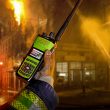FCC seeks comment on aerial communications for first responders
FCC commissioners last week unanimously adopted a notice of inquiry designed to solicit input about the possible use of deployable aerial communications architecture (DACA) technologies for emergency communications when terrestrial communications network may be damaged or otherwise unavailable.
Under the term of the notice — the first item considered by the full FCC with new commissioners Jessica Rosenworcel and Ajit Pai — the public safety and homeland security bureau is seeking information about the best uses of DACA technology, which can be deployed as a “cell tower in the sky” via unmanned aerial vehicles, weather balloons or existing aircraft.
“Antennas in the sky are fact, not fiction,” FCC Chairman Julius Genachowski said during the commission meeting. “And when disaster strikes, they can make a real difference.
“This technology has the ability to temporarily restore critical communications — including emergency response and 911 calling. And it has the potential to do it quickly, even in the first hours after disaster strikes.”
Already used by the U.S. military, DACA technologies are expected to be especially valuable to first-responder organizations entering locales that have been hit by a disaster — for instance, a hurricane — that renders terrestrial networks inoperable. By using quickly deployable DACA systems, handheld and portable radios can continue to operate effectively by transmitting signals to and from the aerial base station until the terrestrial network can be restored.
In such situations, many entities have opted to use satellite technologies, but this strategy has proven challenging, because it requires users to have satellite gear, know how to operate it and be able to pay for the satellite services. With DACA technology, the aerial base station can support myriad systems — from LMR to cellular — including the LTE standard that the nationwide public-safety network will leverage, according to Todd Pressley, director of technology for Oceus Networks, which has developed a DACA solution called Xiphos.
“With satellite, I don’t have a 4G network,” Pressley said. “When those fixed towers are destroyed in a natural disaster, I could quickly launch and restore [DACA] communications for the first responders to communicate amongst each other until the fixed networks are restored.”
Oceus Networks is one of several entities partnering with Space Data, which has supported such communications payloads at near-space altitudes between 65,000 feet and 90,000 feet. Space Data uses weather balloons to lift radio base stations into near space, which is well above weather systems and is characterized by very predictable wind patterns. With minimal obstructions to the near-space base station, regular terrestrial-system handsets can be used to enable communications where terrestrial infrastructure is not available.
Since 2004, Space Data has logged more than 250,000 flight hours in more than 20,000 flights, many of which have supported communications for U.S. military forces deployed overseas. To date, these efforts have supported voice applications, but Space Data an Oceus will conduct a demonstration of their joint LTE solution in Arizona and near Boulder, Colo., which is the location of the Public Safety Communications Research (PSCR) LTE test network.
“In addition to the responsive nature of combining Space Data’s near space platforms with LTE and P25, these demonstrations will use 700 MHz spectrum recently set aside to expand public safety allocations for such modern communications technologies,” Space Data Chairman and CEO Jerry Knoblach said in a prepared statement.
Among the technical questions that commenters will be invited to address in the proceeding include prioritization of services and access to the DACA system, as well approaches to mitigate potential interference with terrestrial systems as they are restored.

















